Tomato is a thermophilic crop from South America. Along with cucumbers, this is one of the best crops for greenhouses, especially in central Russia. How to prepare a greenhouse for growing tomatoes? Under what conditions can a tomato produce a good crop in a greenhouse? Growing and caring, features and nuances of this business are what will be discussed in this article.
Material Content:
- 1 Varieties of tomatoes resistant to late blight
- 2 Preparing a greenhouse for tomatoes
- 3 Growing seedlings at home
- 4 Planting a tomato in a polycarbonate greenhouse
- 5 Greenhouse care
- 6 The main problems associated with growing
- 7 Why do tomatoes crack in a greenhouse?
- 8 Diseases, pests and methods of dealing with them
- 9 How to prepare a greenhouse for winter after harvest
Varieties of tomatoes resistant to late blight

There are a great many varieties of tomatoes for greenhouses, and new offers appear every year. Therefore, it is more rational to give advice on how to choose a tomato variety for greenhouses than simply list some of them. What criteria and moments are worth paying attention to?
- Disease resistance. The real plague of tomatoes in closed ground is late blight. This is a contagious and almost incurable fungal disease. The bush on which it is found is subject to destruction. The spores of the fungus spread to neighboring plants and will soon manifest themselves. Therefore, it is so important to choose disease-resistant varieties.
- Self-pollinating. Tomato flowers are pollinated with insects and wind. For obvious reasons, the first and second are not enough in the greenhouse. Therefore, self-pollinated varieties are taken, and at the time of active flowering, the greenhouse worker should shake the bushes so that the smallest pollen is in the air and settles on the pistils of neighboring flowers.
- Indeterminacy. This is a property of the bush to grow from the top of the main shoot.In contrast, the determinant cultivars, having reached a certain height, stop growing from the growth point on the stem shoot, remaining thereby undersized bushes. Determinant and semi-determinant varieties are used mainly in open ground, and indeterminate varieties are ideal for greenhouses.
Greenhouse varieties can have an unlimited number of fruit brushes, grow endlessly up until the growing season of tomatoes in the greenhouse. With proper care of such a plant, you can collect 10-20 kg of crop per season.
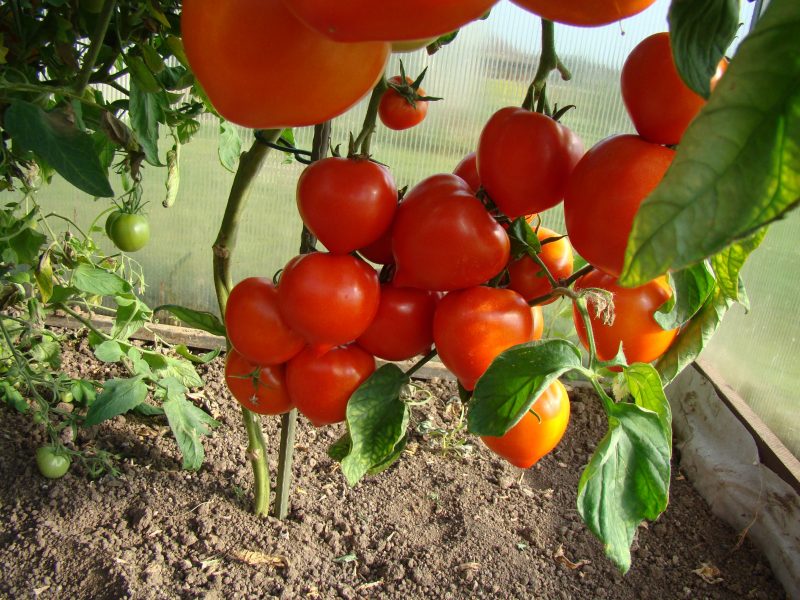
We list only a few greenhouse varieties of tomatoes resistant to late blight that have proven themselves well:
- Black Prince - indeterminate tall variety resistant to fungal infections.
- Bull heart - large-fruited mid-season grade.
- F1 Talitsa - a tall hybrid that is not afraid of waterlogging of the soil, also with good indicators of resistance to diseases and pests.
- Cossack - mid-season greenhouse indeterminate variety.
- De barao - A variety with an interesting plum-shaped fruit.
- Alexy F1 - a hybrid with bright red fruits.
Preparing a greenhouse for tomatoes
The most cost-effective type of greenhouses is a polycarbonate greenhouse, but if you wish, you can cover it with polyethylene or glass.
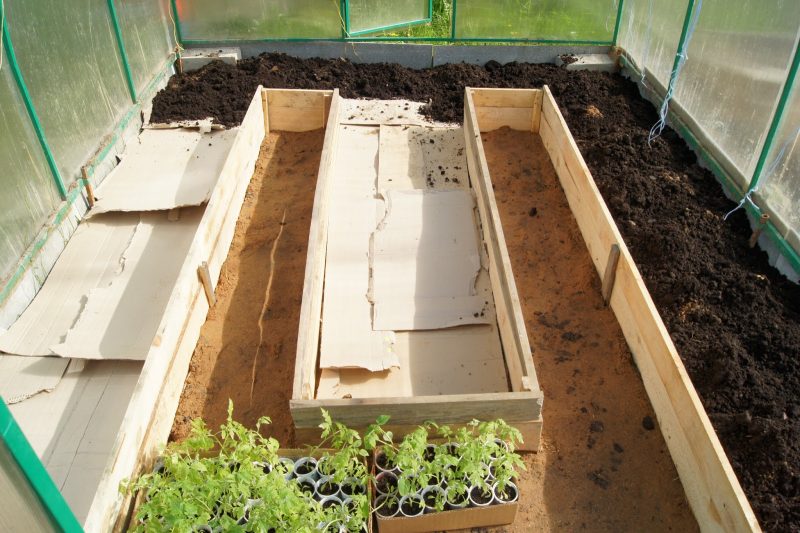
The main thing is that it satisfies several conditions:
- ease of ventilation, for which, in addition to the door, it should have several windows;
- the ability to tie ropes vertically lowering them to the ground;
- height must reach at least two meters, otherwise you will have to grow less productive undersized varieties.
To the place where the plant will be planted, lower the rope, which with the help of a wire or pins should be fixed in the soil. In the future, it will serve as a support for the long stems of the plant.
The soil inside the greenhouse is completely dug up and formed in the form of beds, as in open ground. The width of the ridges is about a meter.
Growing seedlings at home
Greenhouse varieties of tomatoes can be sown on seedlings from late February. It is not too late to do this during the first half of March.

The main nuance at this stage is the choice of soil for seedlings. It should be light and fertile. For this purpose, ready-made soils for seedlings, which are sold in specialized stores, are perfect. If desired, you can independently make a soil mixture of 1 part of ordinary garden soil, 1 part of peat, 1 part of coarse sand. You can also add a small amount of wood ash.
The second point is the seed. Most agricultural companies trade already processed seeds, so all that remains is to soak them in water for a day and drop them in containers. If there is information that they were not processed, you can soak them for a day in a solution of a growth stimulant (Zircon, Epin, etc.), and just before seeding - hold for half an hour in a solution of Fitosporin, and also - spray Phytosporin on the soil surface.
Shallow boxes, 12-16 cm high, are filled with 80-85% soil. Seeds are sown at a distance of about 2 cm from each other, sprinkled with a thin layer of soil, moisten the soil with a spray bottle and cover the containers with a plastic bag or a mini-greenhouse. Boxes should stand at a temperature of 20-25 degrees until that moment when the most part of seeds has risen.
The first seedlings will appear in a week, and the bulk of the seeds will sprout in another 3-5 days. At this point, the temperature in the room should be reduced to 18-20 degrees and include artificial illumination.
Tomatoes are lightened up from 2 to 5 hours every day, depending on the weather and time. The principle is simple: the lamp lasts longer on cloudy days and less on sunny days. Approximately from the 20th of March, the backlighting can be stopped if the weather permits. To illuminate a small amount of seedlings, you can use ordinary fluorescent lamps, which are placed on the opposite side of the window.If the seedlings count for hundreds and, especially, thousands, then you need to purchase either powerful DNAT and DNAZ lamps, or special phyto-lamps.
When 2-4 real leaves appear on seedlings, it is dived into more voluminous containers in which they grow until early May.
The ideal temperature for seedlings is 20-25 degrees during the day and 16-20 degrees at night. These temperature fluctuations contribute to the strengthening of seedlings.
Planting a tomato in a polycarbonate greenhouse
Tomatoes can be planted in closed ground 2 weeks earlier than in open ground. For central Russia, this falls at the beginning of May.
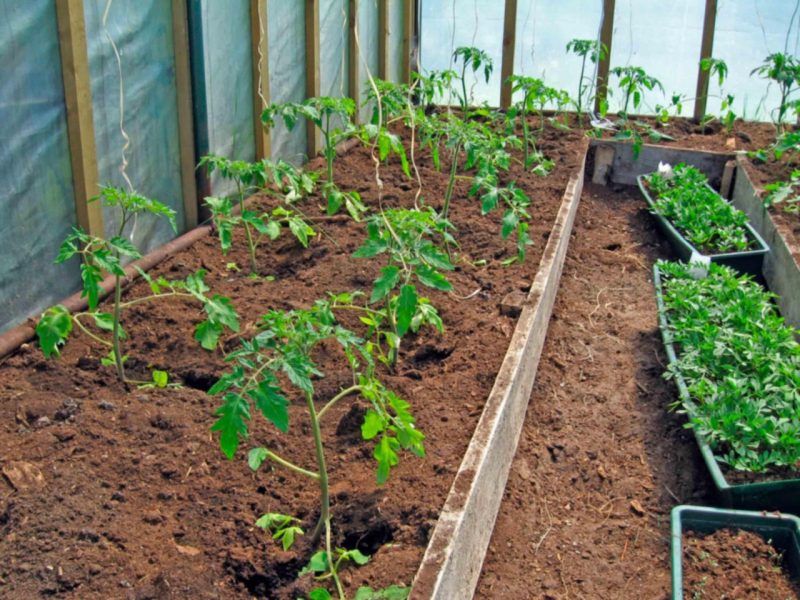
Tomatoes are planted approximately the same as in open ground: on ridges, 0.8-1 m wide in two rows. Plants are staggered 3-4 copies per square meter. Thus, the distance between them is about 0.5 m.
Water the seedlings the day before planting, so that the soil dries out a little by the beginning of the procedures. The planting process is straightforward: a hole is dug to fit the size of the seedling's root system, 2-4 liters of water are poured into it, the tomato is planted, filled with soil and again watered with 1-2 liters of water. It is permissible to bury plants to cotyledon leaves.
The soil is mulched in order to reduce its overheating and evaporation of moisture. Covering material can be straw, sawdust, dry leaves.
Young plants are immediately prepared for formation in one stem: the lower leaves and stepsons are removed.
Greenhouse care
Indeterminate varieties of tomatoes (namely, those grown in greenhouses) form exclusively in one stem. That is, any side shoots (stepsons) are removed from the trunk, and the top is allowed to grow up unlimitedly. Soon after planting, the bush will already need to be tied, for which, at the stage of preparation of the greenhouse, ropes were vertically stretched. Also, for sanitary purposes, all lower leaves are removed from grown plants.
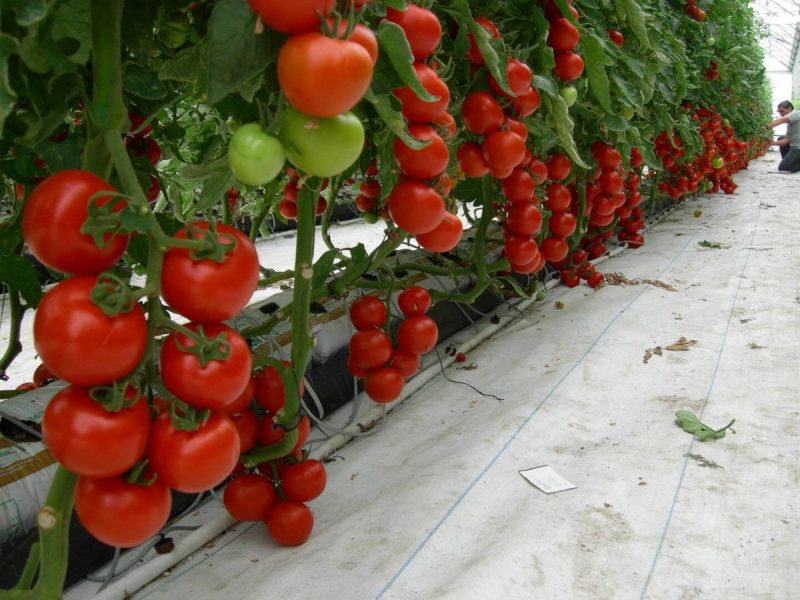
After planting during the first week, it is recommended to refrain from watering the bushes. After 7-10 days and before flowering begins, the tomatoes are irrigated once every 4-7 days, spending about a liter of water for each of them. Starting from the flowering period, the flow rate is increased to 2 liters per copy.
Fertilizing tomatoes in a greenhouse is carried out 2-3 times per season. 3-4 weeks after planting, tomatoes are fed for the first time. During this period, they need all three basic elements in equal amounts, so you can bring in a mixture of mineral fertilizers, making sure that the amount of nitrogen, phosphorus and potassium in the resulting solution is approximately the same. In its pure form, nitrogen, phosphorus and potassium fertilizers are diluted in the amount of 1 tablespoon per 10 liters of water. 1 liter of fertilizer is consumed per bush. You can also make a solution of cow manure in a dosage of 0.5 l of manure per 10 liters of water.
After another 2 weeks, when the formation of ovaries should begin, phosphorus-potassium fertilizers are applied. Dosages are selected according to the instructions on the package.
It is useful to use microfertilizers for tomatoes in a greenhouse 1-2 times per season. There are a great many of them on the market. When choosing, you need to be guided by the consideration that tomatoes require iodine, boron, zinc, manganese, copper. Any product containing these substances will do.
In order to prevent fungal diseases, it is recommended to ventilate the greenhouse daily. On summer days, you can leave windows and doors open for the whole day; tomatoes are not afraid of drafts.
The main problems associated with growing

- Ovaries do not form. If, at the same time, the plants bloom actively, then there is obvious overfeeding of tomatoes with nitrogen fertilizers. It is necessary to water tomatoes abundantly and after a few days to produce phosphorus-potassium fertilizing.
- Dropping leaves and fruits indicates insufficient watering.
Why do tomatoes crack in a greenhouse?
Fruit cracking is a problem that almost everyone who grows tomatoes in a greenhouse faces.
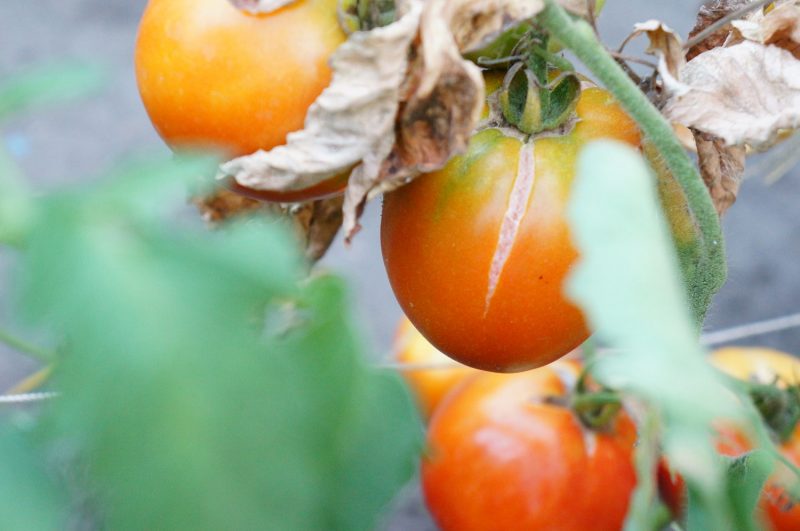
The most common causes are:
- soil overheating;
- heavy watering after a period of drought;
- lack of trace elements;
- varietal predisposition.
To avoid this phenomenon, you need:
- regularly ventilate the greenhouse;
- water the plants evenly, avoiding bays and overdrying;
- mulch the soil;
- to shade the greenhouse on the hottest days using mesh fabric, agrofibre or other means.
Diseases, pests and methods of dealing with them
The most dangerous tomato disease in closed ground is late blight. With late blight, the fruits and ovaries are covered with black spots, deform and fall off. Characteristic spotting also appears on leaves and stems.
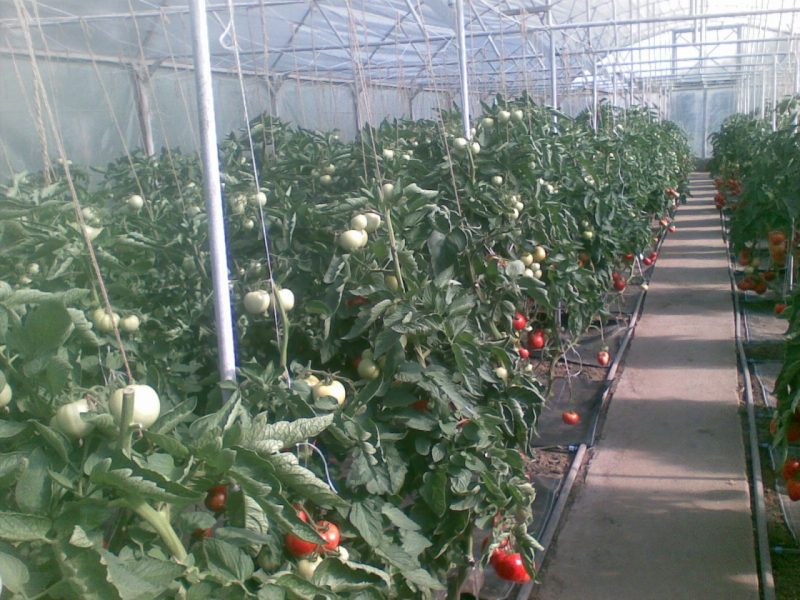
As experience shows, the removal of affected leaves, fruits and stems and treatment with fungicides does not help stop the spread of late blight. There is only one way out: either a cardinal pruning of the bush, if the disease has just begun to appear, or its complete removal.
Another fungal disease of tomatoes is powdery mildew. The basis of its symptom is the appearance of powdery plaque on leaves, stems, fruits. Also a dangerous but treatable disease against which any fungicides can be used.
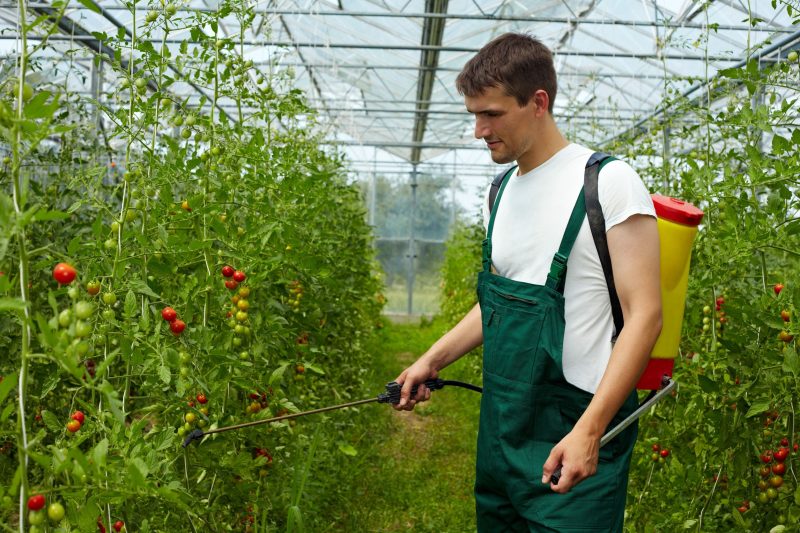
Gray rot - manifests itself primarily on the fruit, less often - on the plant. Fungicides are used against it.
Prevention of fungal diseases is the drug Fitoverm. Plants are sprayed with them, at least in early June and several times in August. But regular processing also does not harm during the whole of June and July every 2-3 weeks.
Of the pests that infect tomatoes indoors, we can name aphids, whiteflies, and thrips. All these insects are easily removed by any insecticides. Say, a whitefly on tomatoes disappears once and for all, even after a single treatment with Inta-Vir. It is recommended to do one preventive treatment in June, and if pests are detected, 2-3 treatments at weekly intervals are recommended.
How to prepare a greenhouse for winter after harvest
Usually the last crop of greenhouse tomatoes is harvested in September. Those who do not have time to ripen by the middle of the month, the fruits are picked green. After this, the plants are removed and burned or dumped into compost pits outside the greenhouse.
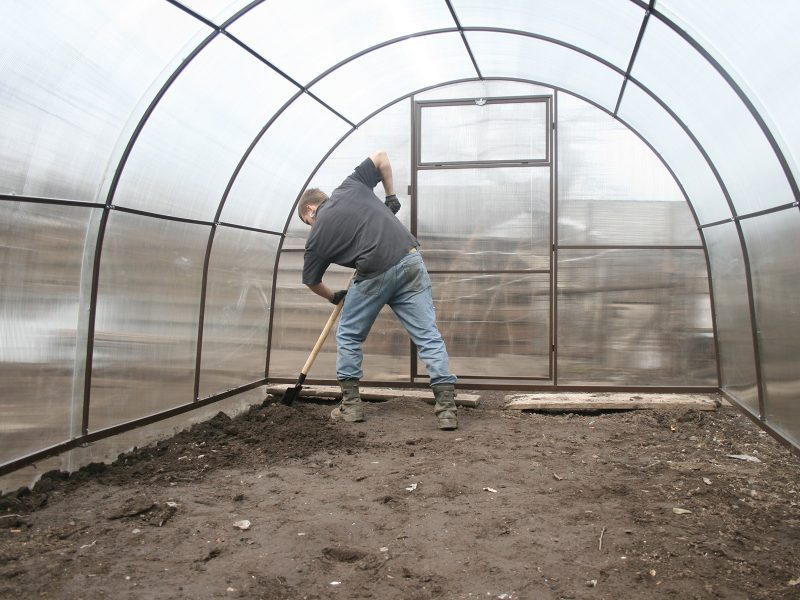
The walls of the greenhouse, all coatings, tools and the soil surface are treated with copper or iron sulfate in order to destroy pathogenic fungi, and polycarbonate is thoroughly washed.
Tomato is extremely thermophilic, therefore it is not surprising that he loves greenhouse conditions and gives greater yields in closed ground than in open air. Growing it in a greenhouse requires some skill, but even those who try it for the first time will achieve better results than summer residents who prefer open ground.












